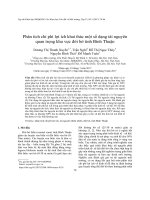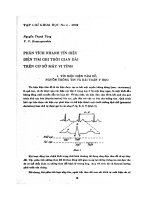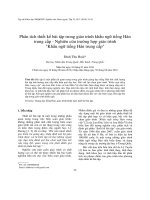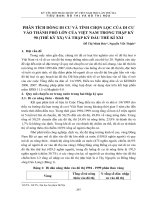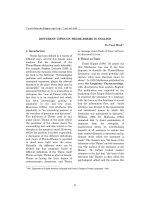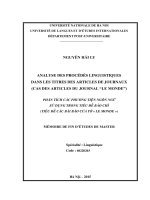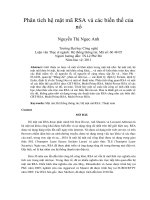DSpace at VNU: Phân tích diễn ngôn phê phán (CDA) (trên cứ liệu một diễn ngôn cụ thể)
Bạn đang xem bản rút gọn của tài liệu. Xem và tải ngay bản đầy đủ của tài liệu tại đây (151.83 KB, 10 trang )
T¹p chÝ Khoa häc ®hqghn, ngo¹i ng÷, T.xxII, Sè 2, 2006
different views on theme-rheme in english
Do Tuan Minh(*)
1. Introduction
as message onset. Each of these will now
be discussed in turn.
Theme has been defined in a variety of
different ways, and for this reason, some
analysts find the dismissal of the
Theme/Rheme distinction easily defensible.
For example, Stephen Levinson (1983: x)
attributes the exclusion of the concept from
his book to the following: “Terminological
profusion and confusion, and underlying
conceptual vagueness, plague the relevant
literature to the point where little may be
salvageable.” An answer to this will be
attempted further on. It is interesting to
juxtapose this view of Theme with the
fact that it is an analytical tool which
has been increasingly gaining in
popularity in the last few years.
Mauranen (1993a: 104) attributes this
popularity to “its interesting position at
the interface of grammar and discourse”.
The definition of Theme used in this
paper places Theme at the point where
the grammar of the clause meets the
surrounding text and also relates to the
thought in the speaker's mind. However,
before the position is further expounded,
a discussion of the different definitions
and views of Theme-Rheme is provided
to shed more light over the issue.
Basically, the different views can be
divided into four categories, based on
different definitions of the Theme itself:
Theme as topic, Theme as given or known,
Theme as having the least degree of
communicative dynamism, and Theme
(*)
2. Theme as Topic
Vande Kopple (1986: 74) points out
that Mathesius was one of the first
linguists to describe the Theme/Rheme
distinction “and his words probably still
capture what most theorists mean by
theme”. In 1930 Mathesius published his
essay On Linguistic Characterology,
with illustrations from modern English.
The publication was regarded as the
beginning of the Prague School tradition.
It analyzed the grammar of a language
with the focus on the functions it served
and the information flow, and “much
attention was devoted to the grammatical
and intentional means by which this
distinction was maintained in discourse.”
(William, 1992: 37). Mathesius (1961)
remarked that “a closer examination of
sentences
from
the
viewpoint
of
assertiveness shows an overwhelming
majority of all sentences to contain two
basic content elements: a statement and an
element about which the statement is
made.” The element was “the basis of the
utterance or the Theme” and the statement
was “the nucleus of the utterance or the
Rheme”. He further invited readers’
attention to the fact that “the basis of the
utterance (the Theme) is often called the
psychological subject and the nucleus (the
MA., Department of English-American Language and Culture, College of Foreign Languages - VNU.
35
36
Rheme) the psychological predicate.”
(Mathesius, 1961: 81) This division was
very important. It disclosed the fact that
besides the grammatical subject and the
grammatical predicate there were other
subjects which stood out on the basis of
their functions in the communication.
According to Mathesius, Theme is the
segment “that is being spoken about in the
sentence” (in Daneš, 1974: p.106).
Mathesius (1975) elaborates further by
stating: “...an overwhelming majority of all
sentences contain two basic elements: a
statement and an element about which the
statement is made” (81): the element about
which the statement, or Rheme, is made is
the Theme.
Researchers often prefer the use of the
term Topic to Theme when referring to
“aboutness”. For Dik (1980), the topic
presents the entity about which the
predication predicates something, while the
Theme is something which is outside the
predication proper, coming before the
clause set off by breaks in intonation. Also,
Witte (1983: 338), defines the topic of a
sentence as “what the sentence is about”.
As topic can be considered a “rather elusive
category” (Downing, 1991: 121), pinning it
can be problematic.
For Connor and Farmer (1990), topic
can be explained as “simply the main idea
or topic of the sentence” and can occur in
many places in a sentence - beginning,
middle, or end” (ibid: 128). They do,
however, point out that this type of topic
identification is fairly intuitive although
they cite research which indicates high
interrater reliabilities on sentence topic
identification. Yet, there are many cases
Do Tuan Minh
where disagreement could occur, as in the
following bit of text,
Without care from some other human
being or beings, be it a mother,
grandmother, sister, nurse, or human
group, a child is very unlikely to survive.
(Witte, 1983: 319)
Witte takes the Subject of the main
clause - a child - to be the topic of the
sentence. However, given that the writer
begins with a prepositional phrase which
could also have been placed after the main
clause, one could just as easily argue that
lack of care is topical in this particular
sentence, not a child. While the term topic
is the most commonly used term for
aboutness, whether it be at the clause level
or at a higher discoursal level (Schlobinski
and Schutze-Coburn, 1992), Theme has
been used, by, for example, Jones (1977), to
refer to the “main idea” or “central thread"
of various levels of discourse. For the nonlinguist, synonyms for theme include
“subject” and “topic”, while for some
linguists, the terms “theme” and “topic” are
used interchangeably. At the same time,
many linguists use the terminology of
topic/comment
and
Theme/Rheme
interchangeably. Witte and Cherry (1986)
assign four functions to topic: i) to a greater
or lesser degree, to express old or given
information, ii) to announce what the
sentence or t-unit is about, iii) to provide
local
coherence
between
individual
sentences or t-units, iv) to guide the reader
in constructing gists and identifying
discourse topics.
In this section, then, we have seen
that the notion of Theme as topic brings
about problems due to the elusiveness of
the term topic in discourse, for which
T¹p chÝ Khoa häc §HQGHN, Ngo¹i ng÷, T.XXII, Sè 2, 2006
Different views on Theme - Rheme in English.
reason Theme as topic will not form the
basis for analysis in the present study.
We have further seen that topic is often
equated with given or known. In the
next section, we will discuss the notion
of Theme as given, an equation which
often comes about via the term topic.
3. Theme as Given or Known
The previous section on Theme as
topic opened with Mathesius and his
definition of Theme as topic. Daneš
(1970) in his explanation of the principle
of utterance and text organization
termed Functional Sentence Perspective
(henceforth FSP), which he attributes to
Mathesius, expounds further:
Analyzing the organization of the
utterance, we state as a rule its bipartite
structure. The two parts (more precisely,
the partial communicative functions
assigned to them) may be defined from two
different points of view:
1. Taking for granted that in the act of
communication an utterance appears to be,
in essence, an enunciation ... about
something..., we shall call the parts THEME
(something that one is talking about,
TOPIC) and RHEME (what one says about
it, COMMENT)...
2. Following the other line, linking up
the utterance with the context and/or
situation, we recognize that, as a rule one
part contains old, already known or given
elements, functioning thus as a “starting
point” of the utterance.... (Daneš, 1970: 134).
However, he later clarifies that
Mathesius maintained from the onset of
his FSP studies that “...theme need not be
a known piece of information” (Daneš,
1989: 25), and argues for a differentiation
T¹p chÝ Khoa häc §HQGHN, Ngo¹i ng÷, T.XXII, Sè 2, 2006
37
of Theme as topic on the one hand, and
known information on the other.
Yet many analysts do not make this
distinction. In many studies based on
the Theme/Rheme construct, these terms
are often conflated with those of
given/new. Babby (1980, in Vande Kopple
1991) identifies Theme as conveying old or
given information. In his view, everything
occurs in an informative declaration as if
the speaker were answering a question;
the speaker makes a mental composition
of what the hearer knows and does not
know and orders the proposition in the
same way as a question. And, in fact, he
ultimately rejects the terms Theme and
Rheme, because of their “terminological
inflation”.
While it is the case that many studies
are more explicit as to the terms used for
the concepts being analyzed and
specifically use the terms “given” or
“known” instead of Theme (likewise using
“new” in place of Rheme), there are
problems in analysis for these concepts.
Vande Kopple (1991) underscores the
nature of the problem in his discussion
of Prince's (1979, 1981) work on given
and new information. Prince's analysis
(based on a taxonomy of given/new on a
scale which goes from unused and
brand-new entities on one end to
situationally or textually evoked on the
other) provides “one of the clearer and
more insightful analyses of these
phenomena available” (Vande Kopple
1991: 315). Yet it is not without
problems. The main problem is that the
line between unused entities and inferable
entities (in the middle of the scale) can
often become blurred (a problem which
38
Prince herself acknowledges). What is
unused information for one reader might
be inferable information for another.
The key to the problem of given (or
Theme as given) here is that the
perspective is that of the reader (listener).
In order to establish what is given in the
clause, it is difficult to establish the
beliefs and presuppositions that the
speaker has about the hearer’s
knowledge about the world, the context
and the co-text.
4. Theme-Rheme in Communicative
Dynamism
Jan Firbas has been more explicit
about and consistent with the definitions
of terms such as Theme/Rheme, and has
employed his analysis with more precision
than other analysts associated with FSP
(Vande Kopple, 1986). In response to
criticisms
of
the
conflation
of
Theme/Rheme with given/new, Firbas
proposed a tripartite configuration of the
utterance-Theme, transition, and Rheme depending on the degree of Communicative
Dynamism (hereafter CD) the linguistic
element
contributes
"toward
the
development of a given purpose" (Firbas,
1986). Within written language, the
distribution of degrees of CD is affected by
the interplay of three factors. The first
factor is that of linear modification, a term
Firbas borrows from Bolinger (1952), and
which means that, provided there are no
interfering
factors,
communicative
importance gradually increases as it
moves towards the end of sentence. The
second and third factors, the context and
the semantic structure respectively, are
interfering factors in that they can work
counter to linear modification. The factor
of context means that an element
Do Tuan Minh
expressing known information, which is
defined by Firbas as information
retrievable from the immediate context
carries a lower degree of CD than an
element conveying a piece of irretrievable,
new, unknown information. Therefore,
context is hierarchically superior to linear
modification and to semantic structure.
The factor of semantic structure refers to
some types of semantic content and some
types of semantic relations, which, if they
are context-independent, can work counter
to linear modification. For example, some
subjects
are
context
independent,
especially in the case of verbs which
denote appearance or existence on the
scene, e.g. A boy came into the room.
Distribution of CD over sentence
elements, then, is determined by an
interplay of the above factors. Therefore,
development of communication cannot
be considered as “a merely linear
phenomenon” (Firbas, 1986: 46). The
dynamics of communication belong to
one of two processes. One of these is the
foundation-laying process: all contextdependent elements are foundationlaying in that they provide a foundation
upon which the remaining elements
complete the information and fulfill the
communicative purpose. The second is
the core-constituting process, in which
elements completing the information
constitute the core of the information.
The Theme is formed by the foundationlaying elements, while the coreconstituting elements form the nonTheme, consisting of the transition (or
those elements performing a linking
function) and the Rheme.
While CD is more highly detailed
than other analyses involving the
T¹p chÝ Khoa häc §HQGHN, Ngo¹i ng÷, T.XXII, Sè 2, 2006
39
Different views on Theme - Rheme in English.
Theme/Rheme construct, it is not
without problems. The first has to do
with practicality: as Martin (1992a)
points out, communicative dynamism is
a matter of degree, there is no need to
draw a line between Theme and Rheme.
However, although there is some
arbitrariness involved in deciding how
far the Theme of an utterance extends,
“it generally proves more practical to
draw a categorical line between Theme
and Rheme” (ibid: 151). Secondly, there
is still some confusion as to how Theme
is defined in CD: as Firbas states: “The
theme expresses what the sentence is
about and constitutes the point of
departure in the development of the
communication” (Firbas, 1986: 54)
4. Theme as Message Onset
In this approach, both the meaning
aspects and the formal aspects of Theme
are considered, as they are both crucial
for an understanding of the Theme/Rheme
construct and its function. Further
specification of the meaning of Theme
according to Halliday involves reference
to “point of departure”: “The Theme is
the element which serves as the point of
departure of the message” (Halliday,
1994: 37). While this conception of
Theme may seem strictly positional,
Fries (1983) makes the point that “there
are good and sufficient internal
grammatical reasons to say that the
beginning is special for some reason”
(118) and goes on to argue that “initial
position in the sentence, or sentence
level Theme, means `point of departure
of the sentence as message” (ibid: 119).
Martin (1992a) provides evidence which
indicates that “point of departure does
T¹p chÝ Khoa häc §HQGHN, Ngo¹i ng÷, T.XXII, Sè 2, 2006
indeed mean something
coming first” (151).
more
than
For Halliday, Theme “provides the
environment for the remainder of the
message, the Rheme.” (Halliday, 1994:
67). Davies (1997) echoes this when he
explains that the Theme initiates “the
semantic journey” of the clause, and he
adds that if a different starting point is
chosen for the journey, a different
journey results. This idea is not a new
one, as Bentham (1839: 268, in Bowers
1988: 92), while not using the label
Theme, talks about the initial element of
a sentence in a similar way: “If a word
expressive of another idea come before it
the mind is in the first instance put upon
a wrong scent; and a sort of correction
and partial change of conception must
have place, before the idea meant to be
conveyed is apprehended”. For Bloor and
Bloor (1995: 72) the Theme in English is
“the idea represented by the constituent
at the starting of the clause”, while for
Vasconcellos (1992: 147), the function of
Theme is “to signal the relationship
between the thought in the speaker's
mind and its expression in discourse”.
She bases her conception of Theme on
work done by Travnicek (1962), who
believed the nature of Theme to be
universal and invariant, expressing the
view that all utterances have Theme,
and that they occur without fail in initial
position. Travnicek's conclusion was that
the principle of the Theme flows from
the relationship between the speaker's
object of thought and its expression in
text. The key notion here is the
relationship between the thought in the
speaker/writer's mind and its expression
in discourse. According to Travnicek,
40
and later Vasconcellos, Theme realizes
the connection between the thought and
the continuation of the discourse.
Speakers/writers choose one element or
another for thematic position based on
the thought they wish to express and
based on how they wish to connect that
thought to the surrounding text.
The Theme, then, has at least a double
function: to express the thought of the
speaker and to indicate the relationship of
that thought to the co-text. Does bringing
in of the speaker’s thought, of cognition, go
too far beyond Halliday’s conception of
Theme? For cognitive linguists, the
psychological dimension of language is
necessary in models of language and
language use in order to “specify in what
different ways natural language users can
play on ” (Dik, 1997b: 58). Butler also feels
that
“a
theory
of
language
as
communication must explore the important
relationships between language and
cognitive structures and processes” (Butler,
1998: 71). Givón is also committed to
“taking cognition and neurology seriously”,
and states: “We will continue to assume
here
that
language
and
its
notional/functional
and
structural
organization is intimately bound up with
and motivated by the structure of human
cognition,
perception
and
neuropsychology” (Givón, 1995:16). Within
Systemic Functional Grammar, Halliday
himself has never been particularly
concerned with the cognitive side of
language, preferring to concentrate on
sociological factors. Nevertheless, the two
elements are by no means incompatible,
and attempts have been made by Fawcett
(1980) to integrate them into a single,
Do Tuan Minh
socio-psychological framework which has
been applied to the description of English.
All the same, in a descriptive text
analysis such as this one, it is necessary to
work from the evidence at hand: the texts
themselves. From a cognitive/psychological
point of view, in a Theme/Rheme study, it
might be of interest to engage in a protocol
analysis of the Thematic choices made by
a writer. Conversely, it might also be of
interest to carry out a similar type of study
from the reader’s perspective, analyzing the
cognitive processes taking place during
reading
with
respect
to
textual
organization (cf. van Dijk & Kintsch, 1983;
Vande Kopple, 1986). Neither of these
types of studies are used here; the study
centers on the linguistic outcome of
cognitive processes, not on the cognitive
processes themselves.
Through analysis of the text itself
and its Theme/Rheme structure “…we
can gain an insight into its texture and
understand how the writer made clear to
us the nature of his underlying concerns"
(Halliday, 1994: 67). Halliday describes
the Theme of the clause as always
containing an experiential element: either
a participant, a circumstance or a process
(Halliday, 1994: 52). These are the
elements of the system of transitivity,
which is “the set of options relating to
cognitive
content,
the
linguistic
representation
of
extralinguistic
experience, whether of the phenomena of
the external world or of feelings, thoughts
and perceptions” (Halliday, 1967b: 199).
The experiential component is: the
linguistic expression of the speaker’s
experience of the external world, including
the inner world of his own consciousness his emotions, perceptions and so on. This
T¹p chÝ Khoa häc §HQGHN, Ngo¹i ng÷, T.XXII, Sè 2, 2006
Different views on Theme - Rheme in English.
component of the grammar provides a
conceptual framework for the encoding of
experience in terms of processes, objects,
persons, qualities, states, abstractions and
relations; it is sometimes referred to as
“cognitive”, and experiential meaning as
“cognitive meaning”, although as suggested
earlier all components presuppose a
cognitive level of organization…The term
“experiential” makes it clear that the
underlying function is seen not as the
expression of “reality” or “the outer world”
but as the expression of patterns of
experience; the content given to an
utterance by this portion of the language
system derives from the shared experience
of those participating in the speech
situation. (Halliday, 1968: 209).
Enkvist (1984) also brings in the notion
of expression of experience in his discussion
of word-order variation, which is key in a
discussion of Theme-Rheme choice. For
word-order choice, he posits three possible
principles, which he terms “textual” as
“they involve parameters outside or beyond
the sentence” (Enkvist, 1984: 56). The first
of these is information structure - old
information first, new later. The second is
what he terms “textual iconicism”, where a
clause may mirror the pattern of a
preceding clause exactly or chiastically (e.g.
he came in triumph and in defeat departs).
The final principle relates to the previous
quote by Halliday, and Enkvist terms it
“experiential iconicism”, which means
"isomorphy between the text and our
experience of the world...symbols of the text
are ordered in the same way as their
referents in the world of things or the world
of events" (ibid: 56). He underscores three
major types: temporal, spatial, and social,
and states that “...corpus studies show the
T¹p chÝ Khoa häc §HQGHN, Ngo¹i ng÷, T.XXII, Sè 2, 2006
41
importance of experiential iconicism in
texts that have to order experience for the
benefit of the receptor. Such texts are
instructions, for instance guidebooks and
cookery-books" (ibid: 57). For Halliday,
moving from thematic Given to a rhematic
New allows a “movement in time” which
“construes
iconically
the
flow
of
information” (Halliday, 1993b: 92). Martin
(1995) discusses the range of information
available for selection as topical Theme in a
particular text as being the characters in
the narrative and the entire contents of the
room. This notion of the range of items
available for Theme as limited is also
shared by Fries: “the perceived simplicity
or complexity of the development of the
ideas in a text will correlate with the
degree to which the experiential content of
the Themes of the text may be seen to be
derived from a limited set of semantic
fields” (Fries, 1995: 324).
Therefore, the use of “cognitive” (or
“idea” or “thought in the speaker’s
mind”) related to the notion of Theme
is used here to refer to the expression
of the speaker’s perception of reality.
Thus, the Theme of the clause, which
formally is the initial element of the
clause, functionally combines the
expression of the speaker’s perception
of reality and the concerns of the
speaker
to
communicate
that
perception of reality to the listener. It
is, thus, both cognitive, in the sense
that it refers to the world of
experience, and communicative, in the
sense that it has a discoursal role.
This combined function of Theme goes
some way in explaining some of the
problems involved with pinning down
the function of Theme. At times, the
42
Do Tuan Minh
speaker/writer chooses as the point of
departure a Theme which relates to
the surrounding text and reflects
concerns of the overall text. At other
times, the speaker/writer chooses a
Theme which reflects the concerns of
the immediate clause. As Berry (1996:
18) expresses it:
[discourse Theme] is something
that a speaker or writer has in
relation to a text or large section of a
text, a priority set of types of meaning
that
reflects
his/her
underlying
concerns for the duration of the text or
large section of text, and that [clause
Theme] is something that a speaker or
writer has in relation to a particular
clause, a (set of) meaning(s) that
reflects his/her priority for that
particular clause.
As explained above, the choice of
Theme manifests a number of different
pressures
(not
least
grammatical
constraints): discoursal pressures include
the wish to relate the point of departure of
one clause with something that has come
before, and experiential pressures, which
include the desire to represent iconically
the pattern of experience through the
clause. Added to this is the notion that “the
priority concerns, discoursal or clausal, of a
speaker or writer need not be ideational”
(Berry, 1996: 19). To support this
statement she refers to Brown and Yule
(1983: 141-3) and their analysis of a
passage of spoken English, in which the
interactional aspect, through the subject
pronouns I and you are thematized. The
main concerns in this spoken passage are
interpersonal.
This conception of Theme separates it
from notions of givenness and aboutness.
While, as stated above, the view of Theme
taken here is separate from that of given, it
is the case that often Theme and given are
conflated. If we take the function of Theme
as
connecting
the
speaker/writer’s
perception of reality with the surrounding
discourse, it is often the case that the item
chosen for thematic position will be
something already given in the previous
discourse: “other things being equal, the
speaker will choose as ‘that from which to
proceed in his discourse’ something that is
‘known or at least obvious’ to the listener”
(Halliday, 1985b: 99). However, that is
not always the case, “other things are
not always equal” (ibid: 99), which
means that, at times, speaker/writers
will choose to introduce a new concern
into the discourse and will do so by
encoding that item as Theme.
Tµi liÖu tham kh¶o
1.
Berry, M., “Thematic Options and Success in Writing”, In M. Ghadessy (ed.), 1995, pp.55-84.
2.
Bowers, F., “Thematization in Legislative Language: the Observations of Bentham and
Coode in Relation to the FG Definition of Theme”, In E.H. Steiner & R. Vetman (eds.) (1988)
Pragmatics, Discourse and Text. London: Pinter, 1988, pp.90-98.
3.
Bloor, T. & M. Bloor., The Functional Analysis of English, London: Edward Arnold, 1995.
4.
Brown, G. & G. Yule., Discourse Analysis, Cambridge, UK: Cambridge University Press, 1983.
T¹p chÝ Khoa häc §HQGHN, Ngo¹i ng÷, T.XXII, Sè 2, 2006
Different views on Theme - Rheme in English.
43
5.
Bolinger, D., “Linear Modification”, PMLA 67, The Modern Language Association, 1952,
pp.1117-1144.
6.
Connor, U. & M. Farmer., “The Teaching of Topical Structure Analysis as a Revision
Strategy for ESL Writers”, In B. Kroll (ed.) Second Language Writing, Cambridge, UK:
Cambridge University Press:, 1990, pp.126-139.
7.
Daneš, F., “One Instance of Prague School Methodology: Functional Analysis of Utterance and
Text”, In P. L. Garvin (ed.) Method and Theory in Linguistics, The Hague: Mouton, 1970.
8.
Daneš, F., “Functional Sentence Perspective” and Text Connectedness', In M.E. Conte, J.
Petöfi, & E. Sözer (eds.) Text and Discourse Connectedness: Proceedings of the Conference
on Connexity and Coherence, Urbino, July 16-21, 1984, Amsterdam: John Benjamins, 1989,
pp.23-31.
9.
Davies, M., “Cohesion in Literary Texts”, Talk given at Saint Louis University, Madrid
Campus, March 3rd, 1997.
10. Dik, Simon C., Studies in Functional Grammar, London: Academic Press, 1980.
11. Downing, A. & P. Locke., A University Course in English Grammar, Prentice Hall
International, 1992.
12. Eggins, S., An Introduction to Systemic Functional Linguistics, London: Pinter Publishers
Ltd, 1994.
13. Enkvist, N.E., “Contrastive Linguistics and Text Linguistics”, In J. Fisiak (ed.) Contrastive
Linguistics: Prospects and Problems, Mouton de Gruyter, 1984, pp.45-67.
14. Fawcett, R.P., “The Semantics of Clause and Verb for Relational Processes in English”, In
M.A.K. Halliday & R. P. Fawcett (eds.) New Developments in Systemic Linguistics, Volume
1, London: Frances Pinter, 1987, pp.130-183.
15. Firbas, J., “On the Dynamics of Written Communication in the Light of the Theory of
Functional Sentence Perspective”, In C.R. Cooper & S. Greenbaum (eds.) Studying Writing:
Linguistic Approaches, London: Sage, 1986, pp.40-71.
16. Fries, P. H., “Themes, Methods of Development, and Texts”, In R. Hasan & P. Fries, (eds.):
1995, pp.317-359.
17. Givón, T., Functionalism and Grammar, Amsterdam/Philadelphia: John Benjamins
Publishing Company, 1995.
18. Halliday, M.A.K., “Notes on Transitivity and Theme in English, Part 1, Journal of
Linguistics 3/1, 1967a, pp. 37-81.
19. Halliday, M.A.K., “Notes on Transitivity and Theme in English, Part 2, Journal of
Linguistics 3/2:, 1967b, pp.199-244.
20. Halliday, M.A.K., “Notes on Transitivity and Theme in English, Part 3, Journal of
Linguistics 4/2, 1968, pp.179-215.
21. Halliday, M.A.K., “Some Grammatical Problems in Scientific English”, In M.A.K. Halliday
& J.R. Martin Writing Science: Literacy and Discursive Power, London: The Falmer Press,
1993a, pp.69-85.
T¹p chÝ Khoa häc §HQGHN, Ngo¹i ng÷, T.XXII, Sè 2, 2006
44
Do Tuan Minh
22. Halliday, M.A.K., The Construction of Knowledge and Value in the Grammar of Scientific
Discourse: Charles Darwin' s The Origin of the Species I. n M.A.K. Halliday & J.R. Martin
Writing Science: Literacy and Discursive Power, London: The Falmer Press, 1993b, pp.86-105.
23. Halliday, M.A.K., Introduction to Functional Grammar, London; Edward Arnold., 1994.
24. Levinson, S. C., Pragmatics, Cambridge, UK: Cambridge University Press, 1983.
25. Martin, J. R., Theme, Method of Development and Existentiality: The Price of Reply,
Occasional Papers in Systemic Linguistics, Volume 6, 1992a, pp.147-183.
26. Martin, J. R., English Text: System and Structure, John Benjamins Publishing Company, 1992b.
27. Martin, J. R., More Than What the Message is About: English Theme, In M. Ghadessy
(ed.), 1995, pp.223-259.
28. Vande Kopple, W.J., Given and New Information and Some Aspects of the Structures,
Semantics, and Pragmatics of Written Texts,In C.R. Cooper & S, 1986.
VNU. JOURNAL OF SCIENCE, Foreign Languages, T.xXII, n02, 2006
xét các quan điểm khác nhau
về khái niệm Đề-thuyết trong tiếng anh
ThS. Đỗ Tuấn Minh
Khoa Ngôn ngữ & Văn hóa Anh-Mỹ
Trường Đại học Ngoại ngữ, Đại học Quốc gia Hà Nội
Bài viết này xem xét các quan điểm khác nhau về khái niệm Đề-Thuyết trong tiếng
Anh. Định nghĩa về đề ngữ được dựa trên bốn góc độ: đề ngữ là chủ đề; đề ngữ là cái cho
sẵn hoặc cái đã biết; đề ngữ là bậc thấp nhất trong động năng giao tiếp và đề ngữ là
khởi đầu của thông điệp.
Trong tất cả các ngôn ngữ, câu bao giờ cũng mang tính chất một thông điệp. Câu có
hình thức tổ chức để làm cho nó có giá trị thông báo và có nhiều cách để thực hiện việc
này. Khi nói hoặc viết, người ta định hướng khai triển của tư duy bằng cách chọn đối
tượng này hay đối tượng khác trong sự tình được diễn đạt làm đề tài để nhận định, để
nói một điều gì đó về nó. Cái bộ phận của câu được chọn làm đề tài ấy được gán một
cương vị đặc biệt và được đưa ra làm đề ngữ. Bộ phận này kết hợp với phần còn lại của
câu - thuyết ngữ - làm thành một thông điệp. Theo định nghĩa này, đề ngữ là yếu tố
được dùng làm điểm xuất phát của thông điệp, là cái mà câu liên quan đến. Nó là cơ sở,
điểm tựa làm bàn đạp cho sự khai triển hành động nhận định của tư duy.
Tạp chí Khoa học ĐHQGHN, Ngoại ngữ, T.XXII, Số 2, 2006
